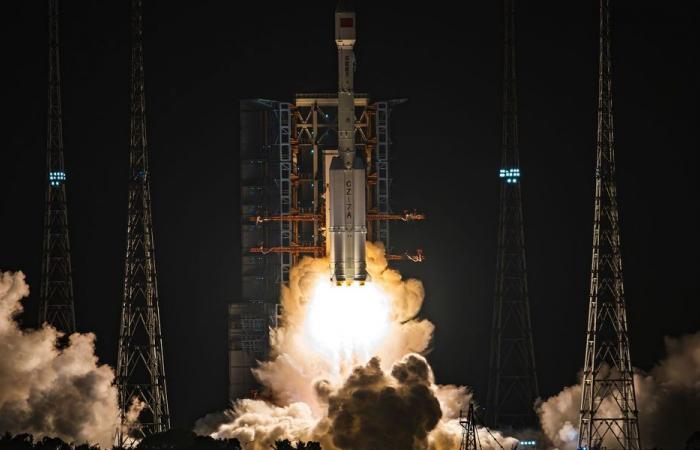China launched its first batch of satellites for its Qianfan megaconstellation earlier this month. It now has 18 satellites in orbit, but much more will be needed to build out this network of nearly 14,000 satellites.
Qianfan—”thousands sails” in Chinese and also referred to as Spacesail or G60—is a project run by Shanghai Spacecom Satellite Technology (SSST). Last February, the company announced it had raised 6.7 billion yuan ($943 million) in funding, with backing from Shanghai’s municipal government. This makes it a serious project, and one meant to catch up with SpaceX’s Starlink, providing global connectivity, including direct mobile connections, while also providing rural connectivity, supporting e-commerce, and bolstering national security within China.
The aim, SSST says, is to launch all 13,904 satellites by 2030. That, incredibly, works out to launching an average of just over seven satellites per day, every day, until the end of the decade.
To put this in perspective, SpaceX, with its reusable Falcon 9 rocket, has launched 6,895 satellites since the Starlink constellation’s first launch in May 2019. Of these, around 5,500 are still in orbit and operational. That works out to about 3.5 satellites launched per day.
To get off the ground, in other words, Qianfan will require both a boom in Chinese launch rates and a surge in satellite manufacturing.
China’s launch capacity is rising
China’s ability to launch spacecraft has grown vastly in recent years. The country launched 22 times in 2016, rising to 67 launches in 2023. Much of this growth has come from the creation of the country’s BeiDou navigation satellite system, the construction of a space station, and the buildout of a national space infrastructure, including large communication satellites and remote-sensing spacecraft for civilian and military uses.
However, none of the Chinese launchers used so far are reusable, and China’s four national spaceports are working at near full capacity. To build Qianfan, SSST and China will need new rockets and new spaceports. The country is working on both.
China has long heeded the rise of private space actors in the United States, such as SpaceX and Planet, and in 2014 the country began allowing private capital into some areas of the space sector. This investment started with small rockets and tiny satellites. More recently, emerging companies have been given the green light to make larger rockets.
The result is that Chinese companies such as Space Pioneer, Landspace, Deep Blue Aerospace and iSpaceare closing in on first launches of medium-lift and/or reusable rockets. Landspace’s reusable stainless steel Zhuque-3, for example, will have a similar payload capacity to low Earth orbit as SpaceX’s Falcon 9, according to the company’s website.A first launch is slated for 2025.
But making rockets and flying frequently and reliably are separate issues.
“In order to increase launch throughput, additional capabilities need to be developed in the launch supply chain,” says Ian Christensen, senior director for private sector programs at the Broomfield, Colo.-based Secure World Foundation.
“In my view it is an open question whether China’s launch vehicle production capabilities can be scaled to meet the throughput necessary to deploy these constellations on the stated schedule,” he says.
The next question is, where will they launch from?
China seeks bigger spaceports
The first launch from a new commercial spaceport on the South China Sea island of Hainan is expected in the near future. It’s close to the national Wenchang spaceport, and two pads have been built so far. One is for a modified Long March 8 rocket—which is expected to play a major role in constellation launches—and the other will host rockets developed by commercial companies. Plans call for up to 10 launch pads. Recently announced plans for space industry developmentfrom Beijing and Shanghai have also been promoted to attract and boost space companies.
Yet whether these plans will translate into definitive action is an open question, according to Christensen. “Ultimately this is about resilience and quality in the supply chain: launch, satellite manufacturing, and terminal equipment,” he says. “Can the various entities involved in this project maintain production at the pace necessary to achieve the deployment schedules outlined?”
Christensen notes that many of the capabilities and entities involved in the Qianfan/G60 project are new, and the projectis not vertically integrated, unlike SpaceX’s Starlink. The latter owns and controls both the launch and satellite manufacturing segments.
“[Qianfan’s] manufacturing entity was established in 2022, and its first satellite was produced in late 2023,” he says. That means fundamental questions about the satellites’ spaceworthiness and durability are as yet unanswered. “How will the products perform in space?” he says. “Will [China’s] manufacturing quality be maintained?”
Those aren’t rhetorical questions, and the answers may have wide repercussions. The first Qianfan/G60 launch, on a Long March 6A on Aug. 6, created a field of hundreds of pieces of debris when the launcher’s upper stage broke up. The accident highlights a worrying issue. Qianfan/G60 satellites will operate at 800 kilometers above Earth, about 250 km higher than Starlink satellites. This means the Qianfan satellites themselves, along with rocket stages and any debris, could remain in space for decades—well beyond their own obsolescence. And that debris would then eventually threaten spacecraft in lower orbits, as it all descends back to Earth.
The rollout of Qianfan/G60 thus has domestic and international ramifications. It heralds a rapid advance in Chinese launch and satellite capabilities. And the acceleration of China’s launch rate to keep up with the project’s ambitious timetables will likely exacerbate the already significant issues of space debris, potential collisions, impacts on astronomy (already recognized by Starlink), orbital crowding, and international cooperation and coordination in space.
From Your Site Articles
Related Articles Around the Web






